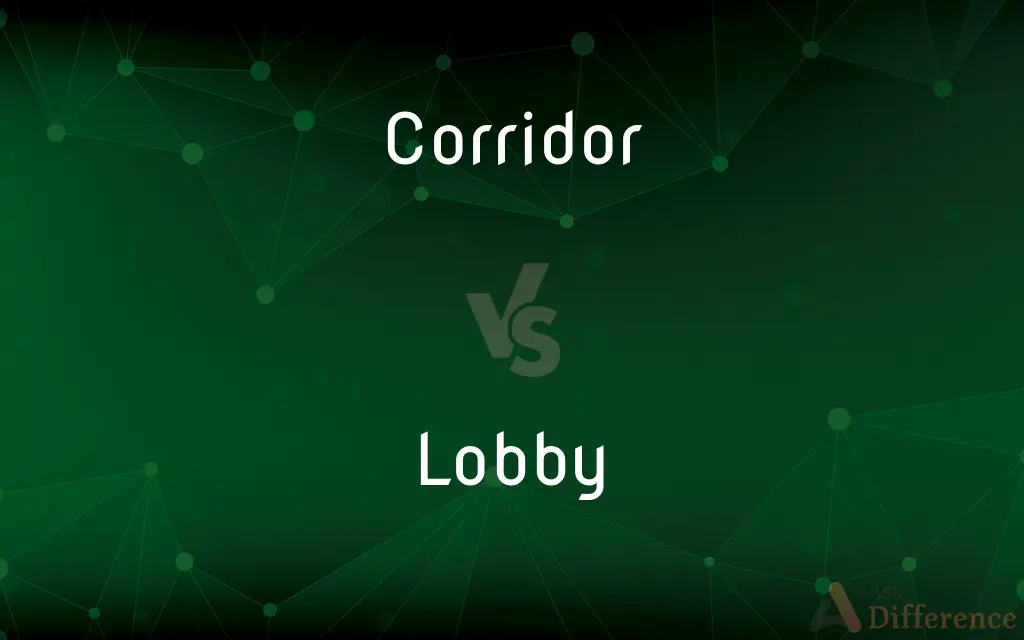Corridor vs. Lobby — What's the Difference?
By Tayyaba Rehman — Updated on September 25, 2023
Corridor is a narrow passage or hallway inside a building, typically allowing access to various rooms, while a lobby is a larger, open space, usually at the entrance of a building, where people can wait or meet.

Difference Between Corridor and Lobby
Table of Contents
ADVERTISEMENT
Key Differences
Corridor and lobby are terms defining different spaces within buildings. A corridor is essentially a narrow pathway or passageway, facilitating movement and access between rooms or spaces within a building, typically lined with doors leading to rooms on either side. It is a transitional space, guiding individuals from one place to another. In contrast, a lobby is a larger, often more spacious area usually located at the entrance of buildings, serving as a waiting or reception area, where individuals can meet, wait, or access other parts of the building.
While corridors are predominantly functional spaces designed to optimize flow and access within buildings, lobbies serve multifunctional purposes, acting as reception, waiting, and often, meeting areas. Lobbies are typically more elaborately designed, reflecting the aesthetic and functional vision of the building, serving as a gateway to the other spaces within. Conversely, corridors are primarily focused on utility, ensuring ease of movement and access to adjoining spaces.
Lobbies, due to their strategic location and multifunctional nature, often feature seating arrangements, reception desks, and decorative elements, creating a welcoming environment and setting the tone for the rest of the building. They act as initial points of contact, where guests can be received and directed. On the other hand, corridors, being transitional spaces, are generally devoid of such amenities, maintaining a clear, unobstructed pathway for movement.
The aesthetic and architectural significance of lobbies is often higher compared to corridors. Lobbies, being the face of the building, are designed to make a statement, reflecting the architectural style and ethos of the building, and are often adorned with artwork, lighting, and decor that align with the building’s overall aesthetic. In contrast, corridors are usually designed with functionality in mind, with less emphasis on aesthetic embellishments.
In essence, while corridors and lobbies are integral components of architectural design, serving to optimize movement and functionality within buildings, they differ substantially in terms of their purpose, design, and aesthetic significance. Corridors act as conduits facilitating access and flow within buildings, while lobbies serve as multifunctional spaces, creating a welcoming ambiance and reflecting the architectural identity of the building.
ADVERTISEMENT
Comparison Chart
Function
Serves as a passage to facilitate movement between rooms or areas.
Acts as a waiting or reception area, usually at the entrance of a building.
Design Focus
Predominantly functional, facilitating flow and access.
Balances functionality with aesthetic appeal, often elaborately designed.
Amenities & Features
Generally devoid of amenities, clear and unobstructed.
May feature seating, reception desks, and decorative elements.
Aesthetic Significance
Lesser emphasis on aesthetics, more on utility.
Higher aesthetic and architectural significance, designed to make a statement.
Size & Location
Narrow and located throughout the building.
Typically spacious and located at the entrance of the building.
Compare with Definitions
Corridor
A transitional space in buildings, primarily designed for movement and access between rooms.
The corridor was lined with doors leading to different rooms on either side.
Lobby
A spacious area inside a building entrance where people can wait or meet.
The hotel had a grand lobby with luxurious decor and comfortable seating.
Corridor
An enclosed pathway within a structure, optimized for flow and utility.
The corridor was well-lit, ensuring safe passage to the adjoining spaces.
Lobby
An initial point of contact in buildings, often serving as a reception or waiting area.
Guests were greeted and assisted in the elegantly designed lobby.
Corridor
A linear, functional space in a building, devoid of obstructions, facilitating ease of movement.
The lengthy corridor connected the various sections of the building efficiently.
Lobby
A multifunctional space in buildings reflecting architectural style and aesthetic vision.
The lobby was designed to make a statement, with artwork and lighting enhancing its appeal.
Corridor
A narrow passageway or hallway inside a building allowing access to various rooms.
He walked down the corridor to reach his office at the end of the hallway.
Lobby
An open space usually at the building's entrance, creating a welcoming environment.
The lobby, with its warm ambiance, set a positive tone for the visitors.
Corridor
An architectural element designed to connect different spaces within a building seamlessly.
The corridor was adorned with minimalistic artwork, adding a touch of aesthetic to the functional space.
Lobby
A strategically located area in a building balancing aesthetic appeal with functionality.
The spacious lobby featured a reception desk and was adorned with decorative elements, making it both functional and aesthetically pleasing.
Corridor
A long passage in a building from which doors lead into rooms
His room lay at the very end of the corridor
Lobby
A hall, foyer, or waiting room at or near the entrance to a building, such as a hotel or theater.
Corridor
A narrow hallway, passageway, or gallery, often with rooms or apartments opening onto it.
Lobby
A public room next to the assembly chamber of a legislative body.
Corridor
A tract of land designated or used for a specific purpose, as for railroad lines, highways, or pipelines.
Lobby
A group of persons engaged in trying to influence legislators or other public officials in favor of a specific cause
The banking lobby.
The labor lobby.
Corridor
A route designated for a specific purpose
A hazardous material corridor.
A sea corridor for shipping.
A flight corridor.
Lobby
To try to influence the thinking of legislators or other public officials for or against a specific cause
Lobbying for stronger environmental safeguards.
Lobbied against the proliferation of nuclear arms.
Corridor
A route or tract of land used by migrating animals.
Lobby
To try to influence public officials on behalf of or against (proposed legislation, for example)
Lobbied the bill through Congress.
Lobbied the bill to a negative vote.
Corridor
A thickly populated strip of land connecting two or more urban areas
People who live in the Boston-Washington corridor.
Lobby
To try to influence (an official) to take a desired action.
Corridor
A narrow hall or passage with rooms leading off it, as in a building or in a railway carriage.
Lobby
An entryway or reception area; vestibule; passageway; corridor.
I had to wait in the lobby for hours before seeing the doctor.
Corridor
A restricted tract of land that allows passage between two places.
Lobby
That part of a hall of legislation not appropriated to the official use of the assembly.
Corridor
The covered way lying round the whole compass of the fortifications of a place.
Lobby
(politics) A class or group of interested people who try to influence public officials; collectively, lobbyists.
The influence of the tobacco lobby has decreased considerably in the US.
Corridor
Airspace restricted for the passage of aircraft.
Lobby
(video games) A virtual area where players can chat and find opponents for a game.
Corridor
A gallery or passageway leading to several apartments of a house.
Lobby
(nautical) An apartment or passageway in the fore part of an old-fashioned cabin under the quarter-deck.
Corridor
The covered way lying round the whole compass of the fortifications of a place.
Lobby
A confined place for cattle, formed by hedges, trees, or other fencing, near the farmyard.
Corridor
Any relatively narrow passageway or route, such as a strip of land through a foreign territory.
Lobby
A margin along either side of the playing field in the sport of kabaddi.
Corridor
A densely populated stretch of land; as, the Northeast corridor, extending from Richmond, Virginia into Maine.
Lobby
(when preceded by "elevator") A waiting area in front of a bank of elevators.
Corridor
An enclosed passageway; rooms usually open onto it
Lobby
(West Midlands) lobscouse
My mam cooked us lobby for tea last night.
Lobby
To attempt to influence (a public official or decision-maker) in favor of a specific opinion or cause.
For years, pro-life groups have continued to lobby hard for restrictions on abortion.
Lobby
A passage or hall of communication, especially when large enough to serve also as a waiting room. It differs from an antechamber in that a lobby communicates between several rooms, an antechamber to one only; but this distinction is not carefully preserved.
Lobby
That part of a hall of legislation not appropriated to the official use of the assembly; hence, the persons, collectively, who frequent such a place to transact business with the legislators;
Lobby
An apartment or passageway in the fore part of an old-fashioned cabin under the quarter-deck.
Lobby
A confined place for cattle, formed by hedges. trees, or other fencing, near the farmyard.
Lobby
To address or solicit members of a legislative body in the lobby or elsewhere, with the purpose to influence their votes; in an extended sense, to try to influence decision-makers in any circumstance.
Lobby
To urge the adoption or passage of by soliciting members of a legislative body; as, to lobby a bill; - also used with the legislators as object; as, to lobby the state legislatuire for protection.
Lobby
A large entrance or reception room or area
Lobby
A group of people who try actively to influence legislation
Lobby
Detain in conversation by or as if by holding on to the outer garments of; as for political or economic favors
Common Curiosities
Can a lobby have multiple levels?
Yes, some buildings have multilevel lobbies, often in hotels or large commercial buildings, to accommodate various functions and amenities.
Is a corridor a common area in buildings?
Yes, a corridor is a common area designed to provide access to various rooms or spaces within a building.
Do corridors always have to be straight?
No, corridors can be designed in various shapes and configurations, including curved or angular, depending on the architectural design of the building.
Is a corridor only designed for walking?
Primarily, yes. Corridors are designed to facilitate movement and provide access, but they can also house utilities like pipelines and cables.
Can corridors have windows?
Yes, depending on the design of the building, corridors can have windows for natural light and ventilation.
Is the size of the lobby proportional to the size of the building?
Generally, larger buildings tend to have larger lobbies, but the size of the lobby is also influenced by the building's function and design considerations.
Can a corridor be outdoors?
Yes, there can be outdoor corridors, typically seen in educational campuses or resort-style accommodations, connecting different buildings or blocks.
Can a lobby serve as a dining area?
It can, especially in hotels, where the lobby area might have a section designated for dining or a connected restaurant/café.
Is a lobby always located at the entrance of a building?
Typically, yes. Lobbies are usually located at the entrance to serve as reception or waiting areas, but some buildings may have additional lobbies on other floors.
Does a lobby need to have seating arrangements?
While not a strict requirement, most lobbies have seating arrangements to accommodate waiting guests or visitors.
Can a building have multiple lobbies?
Yes, large buildings, especially skyscrapers and hotels, often have multiple lobbies, each serving different purposes or different sets of occupants.
Are corridors considered private or public spaces in a building?
In residential buildings, corridors are often considered semi-public spaces, while in commercial buildings, they are usually considered public spaces.
Are there specific building codes for designing corridors?
Yes, building codes typically have specifications for corridor width, lighting, and other features to ensure safety and accessibility.
Is lighting important in corridor design?
Yes, proper lighting is crucial in corridor design to ensure safety and visibility.
Can the design of a lobby impact the perceived value of a building?
Absolutely. The design of a lobby can significantly impact first impressions and perceived value and quality of the building.
Share Your Discovery

Previous Comparison
Regulation vs. Compliance
Next Comparison
Score vs. ScratchAuthor Spotlight
Written by
Tayyaba RehmanTayyaba Rehman is a distinguished writer, currently serving as a primary contributor to askdifference.com. As a researcher in semantics and etymology, Tayyaba's passion for the complexity of languages and their distinctions has found a perfect home on the platform. Tayyaba delves into the intricacies of language, distinguishing between commonly confused words and phrases, thereby providing clarity for readers worldwide.
















































